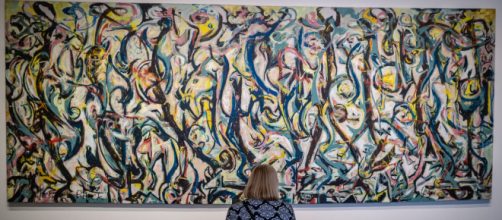The news was straightforward. After getting flooded out in 2008, the University of Iowa Stanley Museum of Art finally opened its doors with 20,000-work collection, including its prized possession: Jackson Pollock’s “Mural.”
But what has been written about “Mural” is anything but straightforward. Sad to say, not everything said is true. Mythologizing tales are told and retold as though to add interest to the artist and his painting presumed not interesting enough.
Separating truth from fiction
“Mural” pictures a continuous band of Abstract Expressionist figures in a rhythmic dance colored blue, yellow, and black, which Pollock described as “a stampede of every animal in the American West, cows and horses and antelopes and buffaloes.
Everything is charging across that goddamn surface.”
The true story about “Mural” began in 1943 when modern art collector Peggy Guggenheim, believing she found the next great American artist, asked Pollock to make a painting for a 20-foot-long foyer wall in her Manhattan townhouse.
But then came the tall tale that Pollock sat staring at the 20 feet of blank canvas without a clue about how to fill it for weeks on end. Reportedly he remained uninspired and grew more and more depressed as time passed.
The tale continues: after weeks of hesitation, on the night before Guggenheim expected the work, Pollock of a sudden began wildly splashing on paint, filling the 160-square-feet in three hours flat!
Faking it
Such a feat never took place. In 2020, Art News magazine told the true story, explaining that the Pollock’s dramatic turnaround came from his wife Lee Krasner in the 1989 Pulizer Prize biography “Jackson Pollock: An American Saga” by Steven Naifeh and Gregory White Smith.
As Art News tells it, a letter from Pollock to his brother in 1944 reveals that “Mural” was not painted in a single night: “I painted quite a large painting for Miss Guggenheim during the summer – 8 feet x 20 feet.
It was grand fun.” I guess there’s not much romance in a fun summer project, and Krasner felt the need to juice it up.
In 2019 The New Yorker, pointed out that both Guggenheim and Krasner were responsible for the myth that Pollock painted “Mural” overnight.
Knowing all that, you have to wonder how much Krasner told Ed Harris, who played the artist in the 2000 movie “Pollock” in scene after scene of drunken binges, tantrums and crying jags.
The way Harris portrays the artist suggested that his aberrant behavior tied in with his improvisational picture-making technique.
But how can that be true? To sustain the wholly integrated continuous dynamic of the rhythmic patterns in “Mural” throughout 160 square feet took discipline, not drunkenness.
And as for Harris’ depiction of Pollock’s aha moment discovering the drip style, well, that didn’t happen, either. The artist didn’t get the idea the way Harris portrayed it, when some squiggles of paint accidentally fell from his brush.
As noted in exhibit literature for a William Baziotes retrospective at California's Newport Harbor Art Museum, it was Baziotes who showed Pollock how paint can be spun with drips.
Clearly, Harris, who directed the movie as well as star in it, adhered solely to the description of the Pollocks’ painting process as described in the bio "Jackson Pollock: An American Saga." If only he had used more than one source, he would have created a bigger picture.
For example, had Harris tapped into B.H. Friedman's book "Jackson Pollock: Energy Made Visible," he could have used what Pollock's wife told Friedman: that he loved to bake, took pride in his home, and adored baseball.
Details like that could not only give more dimension to Harris' portrayal, but allow more truths.


